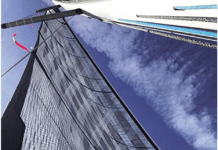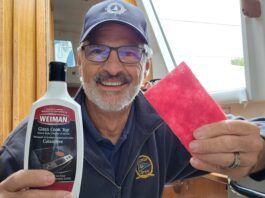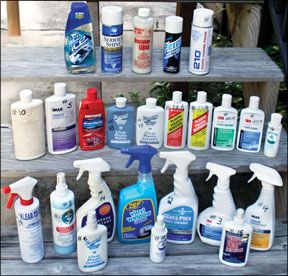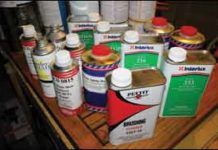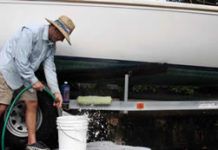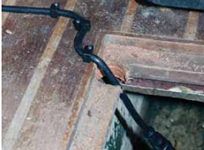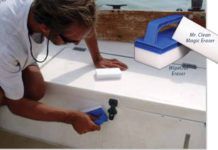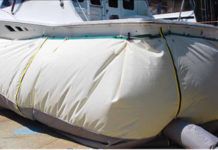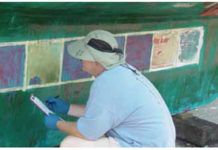Mailport: June 2013
How thick is too thick for the buildup of old layers of bottom paint? This question arises because I have just finished painting the bottom of my boat. Even though I diligently sought out potential flaking spots with my knife, while rolling on the paint (Pettit Ultima Eco), I would frequently get a mess caused by the paint flaking off. I have only owned this boat for three years, so I really do not know how many layers there are.
Indoor Sailboat Refinishing
I am restoring old fiberglass sailing club boats (Rhodes 19s) in a confined, heated space in winter, and I need to paint the topsides, decks, and bilges without poisoning the applicator. What do you suggest for a topside finish (white)? A repairable, long-lasting finish will be valued more than a high-gloss finish. Also, what do you suggest for the bottom paint? The boats will be in fresh water all summer; low environmental toxicity is a high priority.
Best Boat Soaps for Regular Washdowns
Sticking to a regular boat bath regimen not only keeps a boat looking good, but it also helps protect it from unnecessary, accelerated wear and tear. Practical Sailor tested a cross-section of 13 products-aerosol sprays, gels, powders, and liquids-advertised as either boat soaps or wash-n-waxes to find out which one was the best grime buster and which one left topside wax intact. The test lineup included products from well-known marine maintenance manufacturers-Star brite, Interlux, Woody Wax, Nautical Ease, 3M, Sudbury, and Marykate-as well as some familiar in the automotive and home cleaning industries-Mothers, Ecover, Eagle One, and K2r.
Liggett’s Shampoo Soap
After reading PS’s November 2011 report on eco-friendly liquid soaps for onboard bathing, personal-care product maker J.R. Liggett sent us one of his Old-Fashioned Bar Shampoos to try out. Liggett has been making the 3.5-ounce shampoo bar from New Hampshire springwater for 30-plus years. (We reported on his Natural Traveler Kit in the December 2008 issue.)
A Copper Alternative?
Prompted by several reader queries and our own curiosity, Practical Sailor recently launched a test of an electronic alternative to metal-based bottom paints: the M20, an ultrasonic antifouling device from the Canada-based SmartAntifouling. Electronic antifouling uses ultrasound waves to prevent algae and other organisms from attaching to a boat’s hull. A transducer, which is mounted on the hull skin inside the boat, emits a high-frequency vibration that creates a micro-thin layer of rapidly moving water blanketing the hull and making it difficult for barnacles and algae to take up residence there. PS installed an M20 on a Florida-based test boat and will be monitoring its performance this season.
Liggetts Shampoo Soap
After reading PS’s November 2011 report on eco-friendly liquid soaps for onboard bathing, personal-care product maker J.R. Liggett sent us one of his Old-Fashioned Bar Shampoos to try out. Liggett has been making the 3.5-ounce shampoo bar from New Hampshire springwater for 30-plus years. (We reported on his Natural Traveler Kit in the December 2008 issue.)
WipeOut Eraser vs. Mr. Clean Magic Eraser
A few months ago, we noticed that our dock neighbors were cleaning their decks with spongy-looking nanofiber pads. Ditching a multitude of cleaners for one re-usable sponge was quite appealing, so a test was in order. We pitted the original Mr. Clean Magic Eraser from Proctor & Gamble against the WipeOut Eraser made by Ralph Perez. These rectangular, nanofiber pads resemble sponges but they don’t require added cleaner, and both use a unique cleaning action to lift and trap dirt. We used them to clean dirty gelcoat and nonskid, and to tackle the waterline, rust stains, and scuffs on our test boat.
Sodablasting 101
When deciding on a process for clearing antifouling paint and coatings off the bottom of your boat, first define your goals and try to be as minimally invasive as possible. If your boat bottom needs more than a scrubbing but less than a full peel, sodablasting is a technique that will strip bottom paint but leave gelcoat intact. The unique softness of the calcium carbonate powder in sodablasting is effective, and the tented setup keeps the old coating contained. This report outlines the sodablasting process, calculates the cost in time and money, and compares its performance and cost-effectiveness to other bottom-stripping techniques we've tested.
A Mathematical Decision-maker
An easy way to compute the do-it-yourself labor commitment involved is by timing how long it takes to scrape clean two 1-square-foot patches. The first is in the center of the least well-adhered paint; the second is in the midst of an intact portion of the bottom. Dry scrape each section with a thin-bladed putty knife and a sharp drag-type scraper, noting the time it takes to remove about 90 percent of the coating.
Past Adventures with Chemical Strippers
Our foray into sodablasting follows years of testing several different ways to remove bottom paint. Although you can simply attack the bottom paint with a power sander (an 8-inch sander-polisher is probably the most common tool for this purpose), this approach is messy, back breaking, and can expose the do-it-yourselfer to various health hazards. It can also lead to dings and divots in the gelcoat caused by overzealous sanding. Many yards prohibit do-it-yourselfers from sanding antifouling, or offer specific guidelines on how it can be carried out-often prescribing a chemical stripper to help contain the paint residue.













